- Home
- Jack Canfield
Chicken Soup for the Cat and Dog Lover's Soul Page 8
Chicken Soup for the Cat and Dog Lover's Soul Read online
Page 8
“C’mon, girl,” I said. “Let’s get outta here.”
She took another step, and this time there was no mistaking the look of confusion in her eyes. But with each step away from the pen and toward our car, her confusion faded. Not once did she look back at the filthy prison that had been her home for so long.
With her tail sweeping madly from side to side, she trembled with anticipation and joy as she jumped in to the back seat of our car. She poked her nose over the seat rest and started snuffling the side of my face, punctuating her affection with little woofs of excitement.
When my husband got in and started the car, the dog transferred her snuffling to the back of his head. She seemed very pleased to be with us. I think we both knew, even then, that the white dog was going to be ours for a long time.
What we didn’t realize then was that we had probably saved the dog’s life. A few months later, the police had to break into that same house when the neighbors alerted them to continued barking coming from inside. The people living there had gone on vacation for two weeks, leaving numerous cats and dogs inside with inadequate food and water. Many of the neglected animals had to be euthanized. The white dog could so easily have been one of them.
That is how White Fang became our Hannah. The first time she went indoors, I saw that same mildly bewildered look on her face that I’d seen when she left her pen. It appeared again going up her first flight of stairs, and the first time we rubbed her belly. On her first walk in the park, she seemed overwhelmed by the sights and smells around her. She didn’t strain on the leash, but walked steadily in front of me, swinging her head from side to side, her nose twitching.
When she first laid down on her fleece-covered dog bed in a sun-drenched spot in the living room, she looked as if she couldn’t quite believe anything could really be so comfortable. No more awful pen, it had been left behind like a bad dream. Hannah gave a long contented sigh as she rested her head on her paws, closed her eyes and settled into sleep.
Carol Kline
The Princess and the Toad
Some years ago, our family expanded to include a one-year-old Siberian husky named Princess Misha. Like all Siberian huskies, Misha had an innate love of the outdoors, and of course, the cooler the better. She would lie curled up in a ball on top of a snowdrift on the coldest of winter days with her tail flicked over her only vulnerable spot—her nose. When fresh snow fell, she would lay so still that she soon disappeared under a blanket of snow and became a part of the landscape. Every so often, she stood up, shook off, turned in a few circles, and then laid back down to keep watch over her domain.
On warm summer days, she found the coolest corner in the house and spent her days napping. Then after her nightly walk, she’d spend the rest of the evening stretched out on the cool cement of the front patio. All through the hot summers and into the fall, this was her nightly ritual.
One summer evening, as we sat out on the front patio relishing a late-evening breeze, we saw a small toad hop out of the grass, then down the sidewalk to a few feet away from where Misha was lying. Suddenly Misha stood up, walked over to the toad, picked it up in her mouth and then walked back to her resting place and lay back down. She then put her chin down on the walk, opened her mouth and let the toad hop out while we watched in astonishment. The toad sat there in front of Misha’s eyes, the two seeming to stare at one another for some time. Then the toad hopped down the walk and back into the grass.
On other nights that summer, we noticed this same ritual. We commented on the fact that Misha seemed to have a fondness for toads. We worried because some toads can be poisonous, but since she never experienced any ill effect and never hurt them, we didn’t interfere. If she spotted a toad in the street on one of her walks, she would actually run over to it and nudge it with her nose till it had safely hopped off the street and back on to the grass, out of harm’s way.
The following summer was the same. Misha enjoyed cooling off by lying out on the front patio after nightfall. Many times, we noticed a toad within inches of her face. At other times, we watched as she walked into the grass and came back to her resting spot with a toad in her mouth, only to release it. The toads always stayed near her for some time before hopping off into the night. The only difference from the previous summer was that she spent more nights in this manner, and the toads were bigger. A toad always seemed to be close at hand.
One night early in the third summer, after letting Misha out, we watched as a large toad hopped out of the grass and over to her, stopping inches in front of her. Misha gently laid her head down so that her nose almost touched the toad. That was when it finally dawned on us—perhaps there was just one toad! Could Misha have shared the past three summers with the same toad? We called a local wildlife expert who told us that toads can live three to six years, so it was entirely possible. Somehow these two unlikely companions had formed a bond. At first it seemed so strange to us. But then we realized we were very different from Misha too, but the love between us seemed completely natural. If she could love us, we marveled, why not a toad?
Misha had a minor operation that summer, and we kept her indoors for a while afterwards to recuperate. Each night she went to the front door and asked to be let out, but we didn’t let her. Instead, leash in hand, we took her for short walks. One evening a few days later, I went to the front door to turn on the porch light for guests we were expecting. When the light came on illuminating the front stoop, there, to my utter amazement, sat Toad (as we came to call him), staring up at me through the screen door! He had hopped up the three steps from the patio, and we supposed he was looking for Misha. Such devotion could not be denied. We let Misha out to be with her pal. She immediately picked the toad up in her mouth and took it down the steps where she and Toad stayed nose to nose until we brought her in for the night. After that, if Misha didn’t come out soon enough, Toad frequently came to the door to get her. We made sure that the porch light was turned on before dark and posted a big sign on the porch, “Please don’t step on the toad!”
We often laughed about the incongruous friendship— they did made a comical sight, gazing into each other’s eyes. But their devotion sometimes made me wonder if I should regard them so lightly. Maybe it was more than just friendship. Maybe in her stalwart toad, Princess Misha had found her Prince Charming.
Joan Sutula
Sheba
I first met Sheba in 1956. I was a third-grade student at the Round Meadow Elementary School. She was a seven-week-old kitten in a pet-shop window. She caught my eye immediately. I had always wanted a kitten, or at least that’s what I told myself when I saw her there on display.
At first, she didn’t even notice me standing there. I tried tapping on the glass, but her concentration remained elsewhere as she gave full attention to the task at hand. A thousand generations of hunting and stalking instinct were brought to bear as she successfully brought down her quarry—her sister’s tail.
I tapped again. She stared at me for a moment, and the bond was made. Following a brief discussion through the glass we concluded that we were made for each other. I vowed to return later in the day to take her home with me.
Unfortunately, I soon found that the road to kitten ownership was not without obstacles. Mom and Dad didn’t think much of my plans. It seemed that they knew quite a lot about the subject of acquiring pets. “Who ever heard of paying money for a cat? A kitten is something that you can get for free at any barn. Besides, we’re dog people.”
I wasn’t sure what that meant but, even at eight years old, I could see that the only true stumbling stone here was the finances. You see, Sheba came with a stiff price tag, two dollars and fifty cents. “A lot of money for something that you can get for free anywhere.”
Getting my own way this time was not going to be easy. However, I felt up to the challenge at hand and, after a day of typical little kid whining and a chunk of “birthday money” that came from Uncle Lou, Sheba was mine.
I was an instant hi
t with her, and the feeling wasmutual. She slept on my bed every night. We had long and meaningful conversations when no one else was around. In fact, it was Sheba who was largely responsible for my deciding somewhat early in life to pursue a career as a veterinarian.
Through junior high, high school, college and veterinary school, she remained a close feline friend. Many important decisions regarding my career as well as my personal life were influenced by conversations, whether real or imagined, with Sheba.
Though she lived with Mom and Dad while I was busy getting married, raising a family and practicing the profession that she influenced me to join, she remained a close friend and seemed to enjoy visits from me, my wife and kids.
Undoubtedly, it was her influence once again that got me thinking about opening a veterinary hospital for cats only. She seemed to love the idea when we “talked” about it, and I knew from past experience that her judgment was flawless, so I set off down a new career path. In June of 1978, my new hospital, The Allentown Clinic for Cats, opened its doors.
Sheba was twenty-two years old on opening day when Mom and Dad brought her to see me and the beautiful new hospital that she had inspired. They hadn’t warned me in advance that there was a second reason for the visit.
Sheba looked horrible. Apparently she had become quite ill that week. I did a thorough exam and was forced to a bitter conclusion. You see, I had been in practice long enough to know when a situation was hopeless.
It seemed fitting that in the new hospital, Sheba was the first cat whose suffering we could ease. We had the last of our long conversations as she fell gently asleep in my arms.
Michael A. Obenski, V.M.D.
Ranch of Dreams
After reading the book Black Beauty as a child, I dreamed that I would someday have a place—a ranch—where animals would not be abused, but like Black Beauty, would live their lives roaming proud and free.
Yet even in my dreams, I thought more about what the Black Beauty Ranch would not be rather than about what it would be. It would not be a place where animals were primarily to be looked at; rather it would be a place where they were primarily to be looked after. And it would not be a place where animals did what people wanted them to do. Instead, the animals would do whatever they wanted to do, because finally, it would not be a people’s place at all but an animals’ place—a place that the animals felt, from the day they arrived, belonged to them and would always belong to them as long as they lived.
I even dreamed about the sign that would be on the gate at the ranch. It would have on it the words from the last lines of Black Beauty: “I have nothing to fear and here my story ends. My troubles are all over and I am at home.”
Today Black Beauty Ranch is all that I had dreamed of and more than I could have imagined. The Ranch, over a thousand acres located in Texas, is home to almost six hundred animals, including buffalo, horses, chimpanzees, deer, cats and elephants, to name a few. Rescued from cruel situations or retired after years of service, all the animals have the best care we can provide and the most freedom possible. The animals in our sanctuary live in that extraordinary gray area that lies between petdom and wilddom as the following story illustrates.
At the time we first acquired the Ranch, it was to be primarily a home for—of all animals—burros. We rescued the burros from the Grand Canyon and later Death Valley. In both places, they were scheduled to be shot and killed by the National Park Service. After extensive research on the safest and most effective way of getting the burros out of the canyon, we hired highly skilled ropers to catch the burros and then we airlifted them out by helicopter. Altogether, the Grand Canyon rescue took two years and involved saving 577 burros. To my knowledge, not a single burro, horse or rider was badly injured.
Some of the burros we rescued ended up staying on at Black Beauty Ranch. Before the rescue, no one had had much experience with burros, but we found that they were completely charming—intelligent, curious, playful and even humorous. They quickly became our favorite animals and even the groups of people who come to tour the Ranch today, who at first show little interest in seeing the burros, become first respectful, then affectionate, and finally begin to love them just the way we do.
From the beginning though, we had one favorite favorite and that was Friendly. Friendly had come up in a sling under the helicopter in the very first batch of burros we rescued in the Grand Canyon. I was in the corral when she was lifted up and over the rim and delicately dropped to the ground. I was also one of the crew that untied her. As sudden and uncomfortable and even crazy as her rescue had been, she seemed to realize that no one had really hurt her, and therefore we were not all bad. That was why, then and there, in those first moments at the corral when she stood and looked at us and had not trotted away, and then let us come closer and then even came closer herself, I had given her a name.
One evening, I went looking for Friendly in the corral to show some people just how friendly she really was. I kept walking up to burro after burro, but I couldn’t find her. I heard the cowboys sitting on the corral rail laughing at me, but as they often laughed at me, at first I thought nothing of it. But when finally their laughing veered on the uproarious side, I swung around to stare at them and there was Friendly—the whole time she had been plodding along behind me, looking for me as hard as I had been looking for her.
After Friendly finally arrived at the Ranch, we soon discovered she was pregnant, and in good time she gave birth to a burro we called Friendly Two. Soon after Two was born, I went to see the new mother. She spotted me and trotted over with her baby from a distant pasture. Almost always when I see Friendly she has a customary greeting—she pushes her head into my stomach. This time she had started to put her head there all right, but suddenly she stopped, moved back, and instead—with some pride—pushed her baby toward me. Immediately I started hugging and gushing over the baby until suddenly, she pushed her baby away, and pushed her own head hard back into my stomach. It was as if she was saying, in no uncertain fashion, that she wanted to show me her baby all right and even wanted me to hug her, but “enough was enough!”
Burros are such faithful friends. To this day Friendly One, now over twenty years old, and sometimes Friendly Two, will, when I am visiting the Ranch, clump over to the veranda at the main house at four o’clock for tea, tidbits and gossip.
One visitor to the Ranch told me recently, “I have never in my life seen so many happy animals.”
No comment has meant more to me than that.
Cleveland Amory
Prince Charming
Every dog is a lion at home.
Italian Saying
“Hey, Mom, I can read this!” Lorne, our seven-year-old son, shoved the newspaper toward me.
With a grubby little finger under each word, he began: “For free . . .”
He paused, so I filled in: “Rescued, abused spaniel-type . . .”
“. . . male dog,” Lorne continued. “Can’t keep. Needs good home.”
“We already have a dog,” I said, patting my little Maltese.
“But he’s wimpy,” protested five-year-old Lee.
“Let’s just go see what he looks like,” begged the boys.
Twenty minutes later, we were knocking on a door in an apartment building with a large “No Pets” sign. A college student answered and told how he’d stopped to get gas when he saw a man yelling and mistreating this dog. When the student asked if he could have the unwanted animal, the man had roughly lifted the trembling dog into the student’s car and left. As I reached out to pet this cowering, pitiful dog, I felt sores from his massive tick infestation. His ribs stuck out from a dull matted liver-and-white coat, and his huge brown eyes looked at me shyly over a freckled nose. He wagged his tail halfheartedly. Talk about wimpy! One look in those sad eyes, though, and I was hooked.
I bundled him and our four delighted children into the car and hurried to the vet’s office, where we determined he was an English springer spaniel, about two years ol
d. X-rays confirmed several broken ribs; a respiratory infection coupled with severe malnutrition, plus a skin infection, requiring several medications. As I explained to my husband that evening, our free dog was rather expensive.
Somehow, I knew he was going to be worth it.
That evening, I listened as the children held a forum on naming our new pet. Laurie, our nine-year-old, led the discussion. “He’s lived such a sad life, he needs a really good name,” she said. They tossed around several names, when three-year-old Leslie lisped: “How about Printh Charming? He’th alwayth the good guy.”
Thus we found our Prince Charming, admittedly a little ragged. We had our work cut out for us if we were going to transform this pauper of a creature into a dog worthy of his title. Like mother hens, we hovered over him, pouring medicines down his throat and watching his battered body slowly heal. As his sores disappeared, Prince put on weight, and his coat turned glossy.
Even better, he began to relax in our presence and show tentative signs of trust.
Bolstered by his new sense of security, Prince began taking daily jaunts over our four acres, exploring the fields and bringing me back souvenirs from his forays—gnarly sticks or a chunky rock. And then, Prince discovered the barn. That’s where he found his place in this world.
Prince proclaimed himself a nanny. With amusement, we watched as Prince warmed himself to the creatures of the barn—the sheep and goats—but we didn’t realize he was about to become an official midwife. At all the deliveries of each new creature, Prince was first on the spot, comforting the laboring mother and standing watch over the newborn lamb or kid. Prince nuzzled and licked the newborns as if they were his own, and when a newborn took its first wobbly steps, Prince ran around excitedly. What did the real mothers think about all this? They seemed to sense Prince’s calling, and they were unthreatened.

 Chicken Soup for the Nurse's Soul: Second Dose
Chicken Soup for the Nurse's Soul: Second Dose Chicken Soup for the Ocean Lover's Soul
Chicken Soup for the Ocean Lover's Soul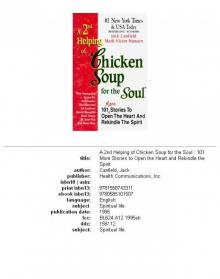 A 2nd Helping of Chicken Soup for the Soul
A 2nd Helping of Chicken Soup for the Soul Chicken Soup for the Nurse's Soul
Chicken Soup for the Nurse's Soul Chicken Soup for the Breast Cancer Survivor's Soul
Chicken Soup for the Breast Cancer Survivor's Soul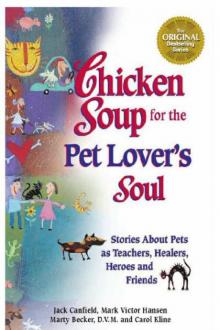 Chicken Soup for the Pet Lover's Soul
Chicken Soup for the Pet Lover's Soul Chicken Soup for the Bride's Soul
Chicken Soup for the Bride's Soul A Chicken Soup for the Soul Christmas
A Chicken Soup for the Soul Christmas Chicken Soup for the Soul of America
Chicken Soup for the Soul of America Chicken Soup for the Teenage Soul on Tough Stuff
Chicken Soup for the Teenage Soul on Tough Stuff A Taste of Chicken Soup for the Teenage Soul III
A Taste of Chicken Soup for the Teenage Soul III Chicken Soup for Every Mom's Soul
Chicken Soup for Every Mom's Soul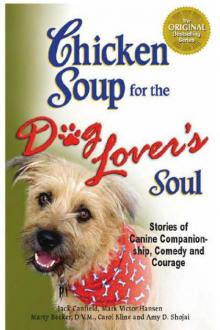 Chicken Soup for the Dog Lover's Soul
Chicken Soup for the Dog Lover's Soul A Second Chicken Soup for the Woman's Soul
A Second Chicken Soup for the Woman's Soul Chicken Soup for the Soul the Book of Christmas Virtues
Chicken Soup for the Soul the Book of Christmas Virtues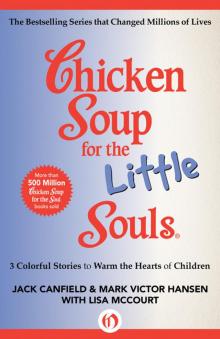 Chicken Soup for the Little Souls: 3 Colorful Stories to Warm the Hearts of Children
Chicken Soup for the Little Souls: 3 Colorful Stories to Warm the Hearts of Children Chicken Soup for the African American Woman's Soul
Chicken Soup for the African American Woman's Soul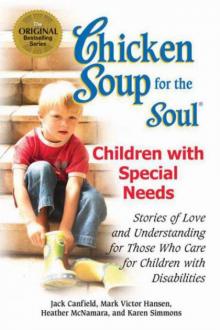 Chicken Soup for the Soul
Chicken Soup for the Soul Chicken Soup for the Soul Celebrates Teachers
Chicken Soup for the Soul Celebrates Teachers Chicken Soup for the College Soul
Chicken Soup for the College Soul Chicken Soup for the Recovering Soul Daily Inspirations
Chicken Soup for the Recovering Soul Daily Inspirations Chicken Soup for the Soul Celebrates Sisters
Chicken Soup for the Soul Celebrates Sisters Chicken Soup for the Dieter's Soul
Chicken Soup for the Dieter's Soul Chicken Soup for the Soul at Work 101 Stories of Courage
Chicken Soup for the Soul at Work 101 Stories of Courage Chicken Soup for the Beach Lover's Soul
Chicken Soup for the Beach Lover's Soul Stories About Facing Challenges, Realizing Dreams and Making a Difference
Stories About Facing Challenges, Realizing Dreams and Making a Difference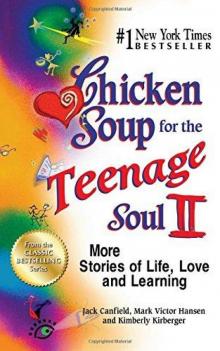 Chicken Soup for the Teenage Soul II
Chicken Soup for the Teenage Soul II Chicken Soup for the Girl's Soul
Chicken Soup for the Girl's Soul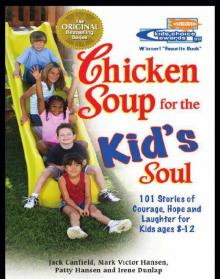 Chicken Soup for the Kid's Soul: 101 Stories of Courage, Hope and Laughter
Chicken Soup for the Kid's Soul: 101 Stories of Courage, Hope and Laughter Chicken Soup for the Woman's Soul
Chicken Soup for the Woman's Soul Chicken Soup for the Cancer Survivor's Soul
Chicken Soup for the Cancer Survivor's Soul Chicken Soup for the Canadian Soul
Chicken Soup for the Canadian Soul Chicken Soup for the Military Wife's Soul
Chicken Soup for the Military Wife's Soul A 4th Course of Chicken Soup for the Soul
A 4th Course of Chicken Soup for the Soul Chicken Soup Unsinkable Soul
Chicken Soup Unsinkable Soul Chicken Soup for the Soul: Christmas Magic
Chicken Soup for the Soul: Christmas Magic Chicken Soup for the Grandma's Soul
Chicken Soup for the Grandma's Soul Chicken Soup for the Soul: All Your Favorite Original Stories
Chicken Soup for the Soul: All Your Favorite Original Stories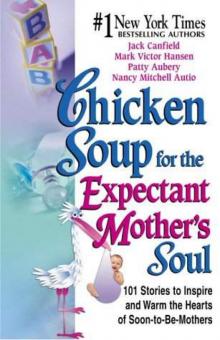 Chicken Soup for the Expectant Mother's Soul
Chicken Soup for the Expectant Mother's Soul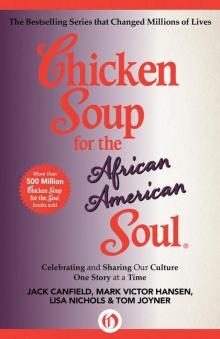 Chicken Soup for the African American Soul
Chicken Soup for the African American Soul 101 Stories of Changes, Choices and Growing Up for Kids Ages 9-13
101 Stories of Changes, Choices and Growing Up for Kids Ages 9-13 Christmas Magic
Christmas Magic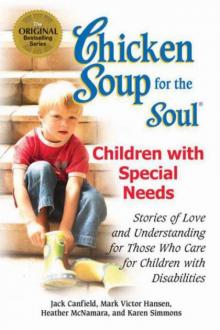 Chicken Soup for the Soul: Children with Special Needs
Chicken Soup for the Soul: Children with Special Needs Chicken Soup for the Soul: Country Music: The Inspirational Stories behind 101 of Your Favorite Country Songs
Chicken Soup for the Soul: Country Music: The Inspirational Stories behind 101 of Your Favorite Country Songs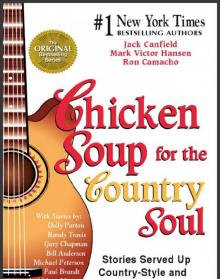 Chicken Soup for the Country Soul
Chicken Soup for the Country Soul Chicken Soup for the Recovering Soul Daily Inspirations (Chicken Soup for the Soul)
Chicken Soup for the Recovering Soul Daily Inspirations (Chicken Soup for the Soul) A 3rd Serving of Chicken Soup for the Soul
A 3rd Serving of Chicken Soup for the Soul The Book of Christmas Virtues
The Book of Christmas Virtues Chicken Soup for the Soul at Work
Chicken Soup for the Soul at Work Chicken Soup for the Soul 20th Anniversary Edition
Chicken Soup for the Soul 20th Anniversary Edition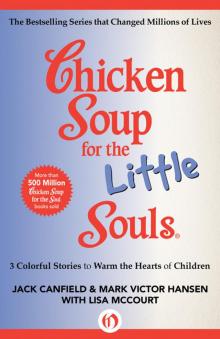 Chicken Soup for the Little Souls
Chicken Soup for the Little Souls Chicken Soup for the Soul: Reader's Choice 20th Anniversary Edition
Chicken Soup for the Soul: Reader's Choice 20th Anniversary Edition Chicken Soup for the Soul Christmas
Chicken Soup for the Soul Christmas Taste of Chicken Soup for the Teenage Soul III
Taste of Chicken Soup for the Teenage Soul III Chicken Soup for the Unsinkable Soul
Chicken Soup for the Unsinkable Soul Chicken Soup for the Preteen Soul II
Chicken Soup for the Preteen Soul II